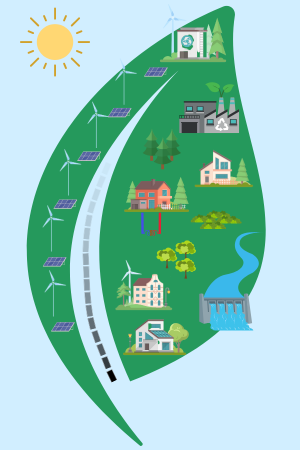
AIR SOURCED HEAT PUMPS
Energy from nature
ENERGY PRODUCTION
In an era of soaring energy prices and heightened environmental concerns, innovative and efficient heating solutions are more crucial than ever.
One such innovation that's gaining considerable attention is the air source heat pump (ASHP). It's not only impressively efficient but also significantly reduces carbon emissions, making it a popular choice for homeowners seeking energy independence and environmental sustainability.
Heat absorption for power
Air source heat pumps absorb heat from the outside air to heat buildings and provide hot water. They can extract heat even when the outside temperature is as low as -15°C.
ASHPs operate on electricity but are incredibly efficient in their energy use, often producing up to three times the amount of heat energy as the electrical energy they consume.
ASHP systems can provide numerous benefits. Firstly, they offer a cost-effective heating solution. While the initial installation costs might be higher than traditional systems, the reduction in fuel bills, particularly for those replacing electric, oil, LPG, or coal systems, can be substantial.
Additionally, under schemes like the UK's Renewable Heat Incentive, homeowners can receive payments for the heat they generate using an ASHP, further offsetting installation costs. When replacing traditional heating systems in older buildings, however, it’s important to consider that modifications might be needed to insulation and radiators to accommodate the lower heat output of ASHPs.
Environmentally, ASHPs significantly lower carbon emissions, especially when replacing conventional fossil fuel-based heating systems. Since they use outside air, a renewable resource, to generate heat, they are classified as a form of renewable energy technology.
Moreover, ASHPs offer the convenience of heating and cooling in one system. In warmer months, the system can be reversed to operate like an air conditioner, providing cool air to the building. This versatility makes it a year-round solution for indoor comfort.
Despite these advantages, there are considerations to note when thinking about an ASHP. They require electricity to function, so while they reduce carbon emissions, they're not entirely carbon-neutral unless paired with a renewable electricity source, such as solar panels.
ASHPs also perform best in well-insulated homes where the heat loss is low. They provide heat at lower temperatures over much longer periods than traditional boilers, so in poorly insulated homes, they may need to be supplemented by other heat sources.
Lastly, while ASHPs can work at temperatures as low as -15°C, their efficiency does drop as the temperature falls, making them less suitable for regions with extreme cold weather.
With these factors in mind, it's clear that while an ASHP might not be a universal solution, in the right circumstances, it offers an efficient, cost-effective, and environmentally friendly heating solution.
In conclusion, air source heat pumps represent an important step forward in home heating technology. They symbolize a move towards greater energy efficiency, cost savings, and lower carbon emissions, aligning closely with global sustainability goals. By considering the adoption of such technology, homeowners can actively participate in shaping a greener, more sustainable future.
Air sourced heat pump process
Assessment
A professional assessor will consider your home's heating and cooling needs based on its size, design, insulation quality, and your local climate.
Based on your home's energy needs assessment, we will help you choose a heat pump with the appropriate heating/cooling capacity.
We consider the Seasonal Performance Factor (SPF) and Coefficient of Performance (COP) when suggesting the unit to ensure energy efficiency.
Installation
Our installer will set up the outdoor unit in a suitable location, considering optimal airflow and minimisation of noise and visual impact.
Depending on the type of ASHP, our installer will integrate the indoor unit with your existing heating system or set up a new one, which may involve installing new ductwork or radiators.
A qualified electrician may need to set up or verify the electrical connections to ensure they meet local codes.
Inspection
After installation, the system must be thoroughly tested for functionality and efficiency.
Depending on local regulations, you may need an official inspection to confirm the system is installed correctly and safely.
We ensure you receive all warranties, manuals, and documentation for your new system.
Our installer will show you how to operate the heat pump, adjust settings, and recognise any signs of potential issues.

